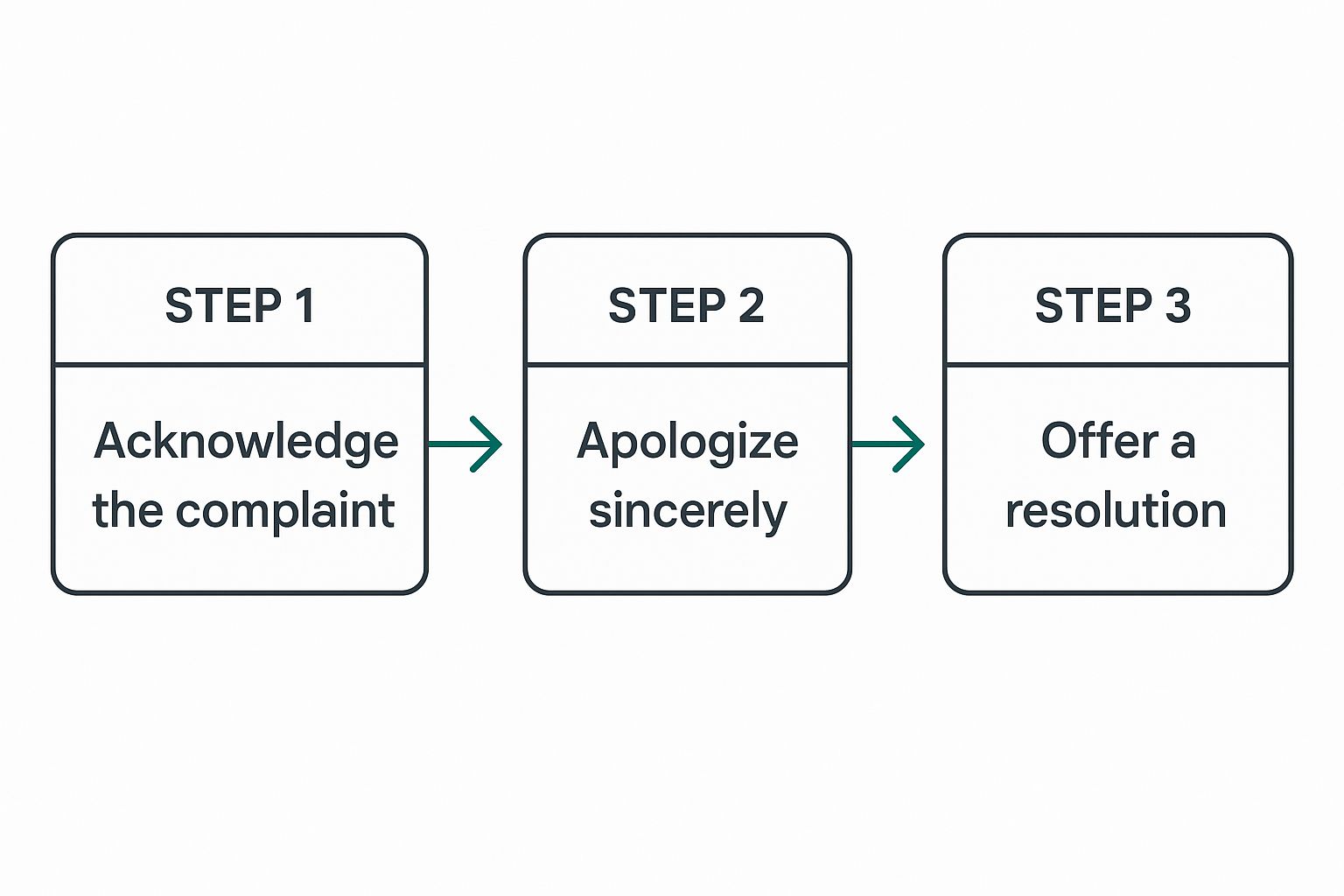How to Respond to a Negative Google Review: A Small Business Guide
Learn how to respond to a negative Google review effectively. Expert tips to protect your reputation and turn criticism into opportunity.
That first one-star review feels like a punch to the gut. After pouring so much into your small business, a public complaint can feel personal. But here's the secret: act quickly, stay professional, and focus on solving the problem. This approach doesn't just protect your reputation; it can turn a negative into a powerful tool for improving your business.
Don't Just See a Bad Review—See an Opportunity

When that notification pops up, it’s easy to get defensive. But before you type a word, take a breath and see the bigger picture. A negative review is a public, and frankly, huge opportunity for your small business.
Your response isn't just for the unhappy customer. It’s a live demonstration of your customer service for every future customer who finds you on Google. They want to see what happens when things go wrong. Do you get defensive, or do you step up and show you’re a business that takes responsibility? Your reply is your chance to prove you're the latter.
How Criticism Can Build Your Credibility
For Australian small businesses, the numbers are clear. Research shows that 76% of shoppers check star ratings before making a choice, and a massive 86% will actively avoid businesses with poor feedback. You can find more details on these Australian consumer trends at Shapo.io. This makes managing your Google reviews one of the most important marketing jobs you have.
Here's how a thoughtful reply helps your business:
Impress Future Customers: A great response shows you’re trustworthy, attentive, and dedicated to customer satisfaction. This makes new people far more likely to choose you over a competitor.
Win Back the Original Customer: Simply acknowledging their frustration and offering a real solution can often turn a critic into a loyal customer who appreciates that you made things right.
Gain Actionable Business Insights: A complaint can shine a light on a real problem you didn't know you had—maybe a communication gap with your team or a supplier issue—that you can now fix for good.
Your response is a public billboard for your customer service. It tells potential customers more about your character and professionalism than a dozen five-star reviews ever could. It’s your moment to prove you’re a business that listens and cares.
To nail your response every time, use this simple framework.
Core Components of an Effective Review Response
This table breaks down the essential elements every great response should include. Think of it as your quick-reference checklist before you hit "post".
Component | Why It Matters for Your Business |
|---|---|
Acknowledge the Customer | It shows you’re listening and validates their feelings, immediately de-escalating the situation. |
Take Responsibility | A simple apology (even if you disagree) demonstrates humility and professionalism to onlookers. |
Provide Context (Carefully) | Briefly and politely clarify any misunderstandings without sounding defensive or making excuses. |
Offer a Solution | Propose a concrete next step to resolve the issue, showing you’re committed to making things right. |
Take it Offline | Provide contact details (phone or email) to move the detailed conversation out of the public eye. |
By consistently including these five elements, you create a response that not only addresses the initial complaint but also actively builds trust with every potential customer who reads it.
Your Pre-Response Checklist Before You Reply
 Reacting instantly when you feel attacked is a classic mistake that can pour fuel on the fire. Before you type a single word, run through this quick mental checklist. It will help you respond with facts, not frustration, and protect your hard-earned reputation.
Reacting instantly when you feel attacked is a classic mistake that can pour fuel on the fire. Before you type a single word, run through this quick mental checklist. It will help you respond with facts, not frustration, and protect your hard-earned reputation.
The very first thing to do? Pause and take a breath. Seriously. Detaching emotionally is the most important step. A defensive or heated reply only validates the reviewer's complaint in the eyes of other potential customers and makes your business look unprofessional.
Once the initial sting has faded, it's time to do some digging. The goal is to get the full story so you can figure out how to respond to the negative Google review in the most helpful way possible.
Investigate the Claim Thoroughly
Your first move is to verify what the reviewer is saying. Is there truth to their complaint? This is where you have to look at the facts.
Check Your Records: Can you find a customer with that name in your booking system, invoices, or CRM? Look for sales receipts, work orders, or project notes from around the date they mentioned.
Talk to Your Team: If you have staff, chat with them calmly. Ask if they remember the customer or the situation described. It’s crucial to get their side of the story without placing blame.
Remember, this investigation isn't about gathering ammunition to prove the customer wrong. It’s about getting a clear picture so you can offer a genuine and informed response.
A response based on facts is always stronger than one based on emotion. Taking the time to investigate shows you respect the feedback enough to take it seriously, which is a powerful message for everyone reading.
Confirm if the Reviewer Is a Genuine Customer
After checking your records and talking with your team, you should know if the complaint is from a real customer. This is a critical fork in the road.
If you can't find any trace of them, you might be dealing with a fake review. That requires a completely different strategy, which we'll cover later.
But if they were a real customer, you’re now armed with the context you need to write a thoughtful and effective reply. This prep work moves you from a defensive position to a confident, problem-solving one.
Crafting the Perfect Response to a Negative Review
Alright, you've taken a deep breath and done your homework. Now it's time to write your reply. Think of this as an opportunity, not damage control. A well-crafted response can soothe an unhappy customer and show everyone else that you're a stand-up business that cares about getting it right.
First, use their name if they've provided it. A simple "Hi Sarah" feels much more personal than "Dear Customer." It’s a small detail that shows you're paying attention.
Next, offer an apology. This is a must, even if you think the complaint is unfair. You’re not necessarily admitting fault for everything; you're apologising for their bad experience. A simple, "We're very sorry to hear you had a frustrating experience with us" is often the perfect opening.
Acknowledge Their Specific Problem
This is what separates a genuine reply from a generic, copy-paste job. You must show you’ve read their feedback by mentioning the specific issue they raised. This simple act validates their feelings and proves you’re not just brushing them off.
Here are a few actionable examples for small businesses:
For a plumber: "We sincerely apologise that our technician left a mess behind after finishing the job."
For a cafe: "I'm very sorry to hear your coffee was cold and that our service wasn't up to scratch."
For a landscaper: "We're sorry for the delay in starting your garden project and understand your frustration."
By reflecting their issue back to them, you immediately de-escalate the situation. It shifts the dynamic from a confrontation to a conversation about finding a solution.
This visual breaks down the simple, three-part flow for a great response.

As you can see, the key is to move from acknowledging the issue to showing you care, and finally, offering a clear way to fix it.
Offer a Solution and Take the Conversation Offline
This is the most critical piece of the puzzle. Your public reply should always offer a clear path to resolution and, crucially, invite the customer to continue the conversation privately. You don't want a long, detailed back-and-forth for all your future customers to see.
In Australia, this approach is highly effective. Research shows that around 7 in 10 consumers look favourably on businesses that respond to reviews, and it heavily influences their buying decisions. A reply that offers a sincere apology and a direct line to make things right is exactly what potential customers want to see. You can find more insights on Google review engagement in Australia here.
The Golden Rule: Your goal isn't to win the argument; it's to solve the problem. The public reply is for all your potential customers, but the private follow-up is for the person who had a bad experience.
Give them a direct contact point. Don't just say "contact us." Provide a specific name, email, or phone number. For example: "We genuinely want to make this right for you. Could you please call me directly on [your phone number] or email me at [your email]? I'd like to sort this out personally." This allows you to discuss specifics like refunds or redoing work away from the public eye.
Dealing With Fake Reviews and Other Tough Situations

Not every one-star review comes from a real customer experience. Sooner or later, you'll probably get hit with a review that seems malicious, is from a competitor, or is completely made up. These situations feel personal, but they demand a different playbook.
First, take a moment to see if the review violates Google's content policies. It's a long shot, but worth checking.
A review might be removed if it includes:
Harassment or hate speech: Personal attacks, threats, or discriminatory language.
Off-topic rants: The review is about something totally unrelated to their experience with your business.
Spam or fake content: This covers reviews from bots, fake accounts, or a competitor trying to sabotage your rating.
If you spot a clear violation, report it. In your Google Business Profile, find the review, click the three dots, and select "Report review." Be prepared to wait, as Google is often slow to act and will only remove reviews that are obvious violations.
How to Publicly Respond to a Dodgy Review
While you wait for Google's decision, you still need to post a public response. This is your chance to show potential customers that you are professional and that the review is questionable.
Your reply must be polite, calm, and completely neutral.
When you suspect a review is fake, never accuse the person of lying in your public reply. It just makes you look defensive. Instead, politely state that you can't find any record of them and invite them to get in touch. This move protects your reputation without starting a public argument.
Here’s a template that works perfectly for small businesses:
"Hi [Reviewer's Name], thank you for your feedback. We take customer concerns very seriously, but after checking our records, we can't find any customer or project matching your name or the details in your review. We'd appreciate the opportunity to investigate this further. Could you please contact me, [Your Name], directly at [Your Phone Number] or [Your Email] so we can resolve this?"
This response shows you're professional and responsive, but it also sends a clear, subtle message to anyone reading that this reviewer might not be legitimate. It’s the calm, professional way to defuse a messy situation.
Make That Feedback Work for You
Responding to a bad review is only half the battle. The real magic happens when you treat that feedback as free, unfiltered advice from your customers. This is where you shift from damage control to a genuine growth strategy for your business.
Create a simple system to track feedback. A basic spreadsheet is all you need. Log the date, the core complaint, and how you resolved it. Over time, you'll start to see patterns emerge.
Spotting Patterns and Making Real Changes
Is everyone saying your quotes are confusing? Are multiple reviews mentioning that your team arrived late? These aren't just one-off complaints. They're valuable clues pointing to an area of your business you can improve.
Once you identify a recurring theme, take direct action to fix it at the source.
Communication Breakdowns: If customers feel out of the loop, it might be time to train your team to send proactive updates or to be clearer about project timelines from the start.
Payment or Invoicing Confusion: Are people struggling with your invoices? That’s a signal to simplify the layout or add clearer instructions. A small change here can prevent future headaches.
Workmanship Woes: If you’re getting repeated complaints about the quality of the work itself, that’s a major red flag. This could mean investing in better training for your staff, using higher-quality materials, or adding a final quality check before you call a job "done".
Every negative review is a free consultation. A customer is giving you their valuable time to point out exactly where you can improve. Acting on that advice is one of the most powerful things a small business owner can do to build a better company.
When you take this approach, you're not just putting out fires—you're fire-proofing your business. By fixing the root cause, you drastically reduce the chances of getting the same complaint again. This creates an upward spiral: better service leads to happier customers, which leads to better reviews and a stronger business.
For more deep dives into building a rock-solid online reputation, check out our other small business guides.
A Few Common Questions About Responding to Reviews
As a small business owner, you'll run into a few tricky review situations. Knowing how to handle these common scenarios is a huge part of protecting your online presence. Let's walk through some of the questions I hear most often.
Is It a Good Idea to Offer a Discount in My Public Reply?
It might seem like a good idea to offer a discount or a freebie, but never offer compensation publicly. This can encourage others to leave negative reviews just to get a deal.
Instead, use your public reply to move the conversation offline. Provide a direct email or phone number and invite them to connect privately. You can then work out a fair resolution—which might include a refund, credit, or re-doing the work—but that conversation stays between you and the customer.
How Fast Do I Need to Reply to a Bad Review?
You should aim to reply within 24 hours. A quick response shows the unhappy customer (and everyone else reading) that you're paying attention and you care. Leaving a negative review unanswered for days can make your business look like it doesn't value customer feedback.
A fast response shows you’re on the ball, but a thoughtful response is what actually fixes things. Never fire off a reply when you're feeling angry or defensive. Take a moment to investigate what happened, but don’t let a review linger unanswered for more than a day or two.
What if I Know a Review Is Fake, but Google Won't Take It Down?
This is one of the most frustrating things that can happen to a small business. When Google denies your request to remove a fake review, your only option is to post a calm, professional public reply.
Use the template from earlier: politely state that you have no record of their visit. "Thanks for your feedback. We've looked through our records but can't find a customer with your name or details. We take all feedback seriously, so we’d appreciate it if you could contact us directly at [your email] so we can look into this further."
This approach smartly signals to other potential customers that the review might not be genuine, without getting you into a messy public fight.
Feeling like managing your online reputation is a full-time job you didn't sign up for? SiteStarter builds high-quality websites for tradies and small businesses that get you found on Google. We handle all the technical details, from your site to your Google Business Profile, so you can focus on what you do best. Learn more about how we help businesses like yours get more customers online.